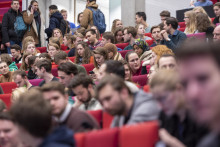The Drienerlo Occupational Health and Safety Services recommended getting defibrillators over two years ago. UT security personnel were the first to be trained. Cardiac defibrillators have already been placed in Hogenkamp, Langezijds, Horst and Cubicus. Now all buildings will be equipped with the device.
EMT Henk Bleijerveld: `In the Netherlands, about fifteen thousand people per year die because of sudden circulation arrest. 80 to 90 percent of those cases are caused by fibrillation, the fast and chaotic shaking of the heart which prevents the blood from circulating. However, EMTs cannot detect fibrillations immediately. If the patient is connected to the device using electrodes, it will automatically control the administering of current surges. The AED increases a patient's chances of survival by 40 to 50 percent.'
The AED instructs the operator with pre-recorded messages. If the heart is not fibrillating, the AED gives the instruction to attempt resuscitation. `Professional medical equipment supplements the cardiac defibrillator well, increasing the chances of a patient's survival', Bleijerveld explains. So far, he has only had to use the machine once.
Trans. Jeroen Latour







